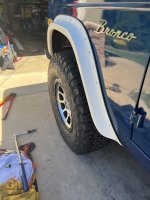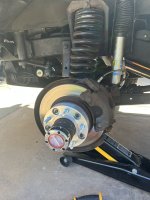Sorry for the late reply. But any time I see the topic of wheel spacers...I usually run away screaming with my fingers in my ears.
Mostly because I always end up hurting someone's feelings...so don't take it personal.
The industry has adapted the name of "wheel adapter" versus "wheel spacer" as a means to differentiate between the two methods of spacing out the wheels. It's just a name. You could have just as easily called the first type "Fred" and the second type "Barney." As long as everybody understands that "Fred" goes with "Wilma" (...and Barney goes with Betty), then it all makes sense, and everybody is happy. Of course the first guy that comes along who never watched the Flintstones thinks you are all a bunch of idiots.
For many years, back in the 1970's I used to despise wheel spacers. Wheel spacers combined with uni-lug ET mags resulted in all kinds of bad things. Oddball mixed depth shank lugs, pulled threads, busted studs, wobbled out holes...just ugly. About 30 years ago, somebody invented the low cost CNC machining center, and started making lug pattern adapters out of 6061T6 aluminum, with machined conical seats, lug centric, and with an additional set of press in studs to allow the use of GM wheels on Ford cars. (solving the infamous 5x4.5 vs 5x4.75 argument) This changed everything. 5 lug Wheel adapters could be mounted properly, secured, and they were awesome. But they could only be made about 1-1/4 inch thick. Steel adapters could be made thinner, but you would have to use shorter lug nuts, and cut off the excess studs. (and pay more money) But whatever. Great solution to let you swap around your GM / Mopar / AMC / Ford wheels around. I don't know how many tires were destroyed by fenders in the 80's. But it was a lot.
But what if you wanted to use that same safe, reliable, economical and available solution as a wheel spacer? Easy enough. You can go from 5x5.5 to the same pattern 5x5.5 and as long as you need at least 1.25 inches of thickness...you can buy the wheel adapter. (yeah, we all know it doesn't adapt anything to anything, and it's really just a spacer. But unless you want a giant washer with 5 holes drilled in it, and 3 inch long lug studs...let's just agree to name it a wheel adapter.) Sometime in about 2007, some genius at Daimler Chrysler thought it would be a good idea to change the back spacing and bolt pattern of the Jeep Wrangler from 5x4.5 to 5x5 and increased the backspace from 4.5 to 6.25 inch. This puts the wheel hub and king pin inside the wheel, and solves lots of cost-cutting initiatives. So if you want to jun Jeep JK wheels on your older TJ or YJ...you just need a wheel adapter. There's probably more of those spacers now than Jeeps.
Along about 1988, the same chassis engineers that put IFS on the front of the GM K2500 figured out that there is an upper limit to the amount of weight that can be carried by a single 235/85/R16 tire. And that amount of weight didn't change if you put an emblem on the side of the truck that said "2500" or "3500." (It took Ford almost 9 more years to figure that out...) Sure, you could put a lot more weight on the BACK of the truck, but the front axle had the same GVW between the 3/4 ton and the 1 Ton. But those pesky Dual rear wheels used a different offset. And we only want one spare tire. So...the "factory" wheel adapter was born. The 1 ton IFS Chevy uses all 3/4 ton outers, with a bolt on wheel adapter. (and enormous brakes!) It's like the GM engineers were handed a JC Whitney catalog from the 70's. But whatever. It PROVED that wheel adapters were safe, effective, durable, and could be used on the front of heavy duty 4x4 applications in pickup trucks. (those same morons put IFS on the 6G Bronco, thus ensuring that Jeep will dominate the off-road market.)
Anyway, back to Broncos and the OP.
@tommyg why do we think that the 57.5 inch wide WMS on a Bronco 9 inch rear axle is the same as the 60 inch WMS of the front dana 44 axle? My math says it's about 2.5 inches narrower. I spend a lot of time building custom rear axles for Early Broncos where I add 2 inches to the rear to match the front. So I'm puzzled about what you have. There's a lot of guys that run custom 31 spline axles and Explorer rear disc in their older 9 inch with a 2.5 brake offset...so they can pick up an extra 1/2 inch or so. But I don't know your configuration. But the factory widths are different front vs rear.
Gotta run...














